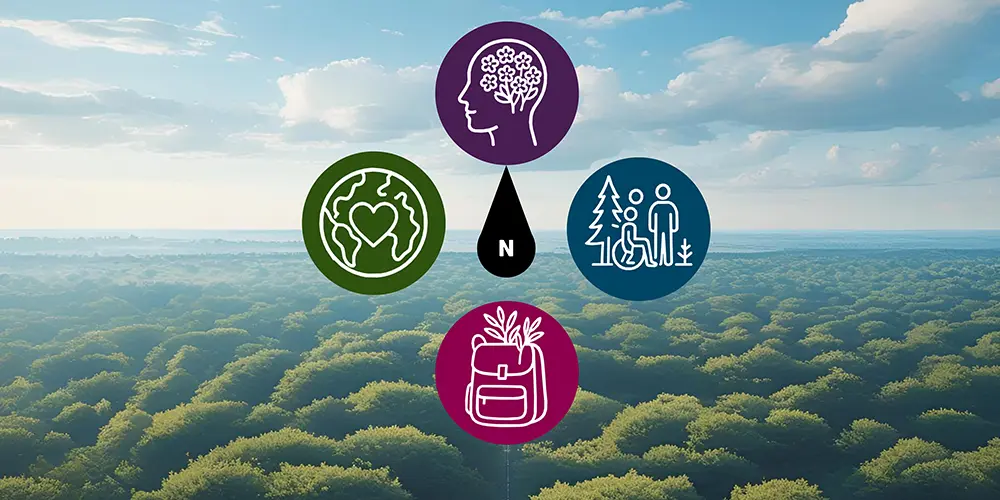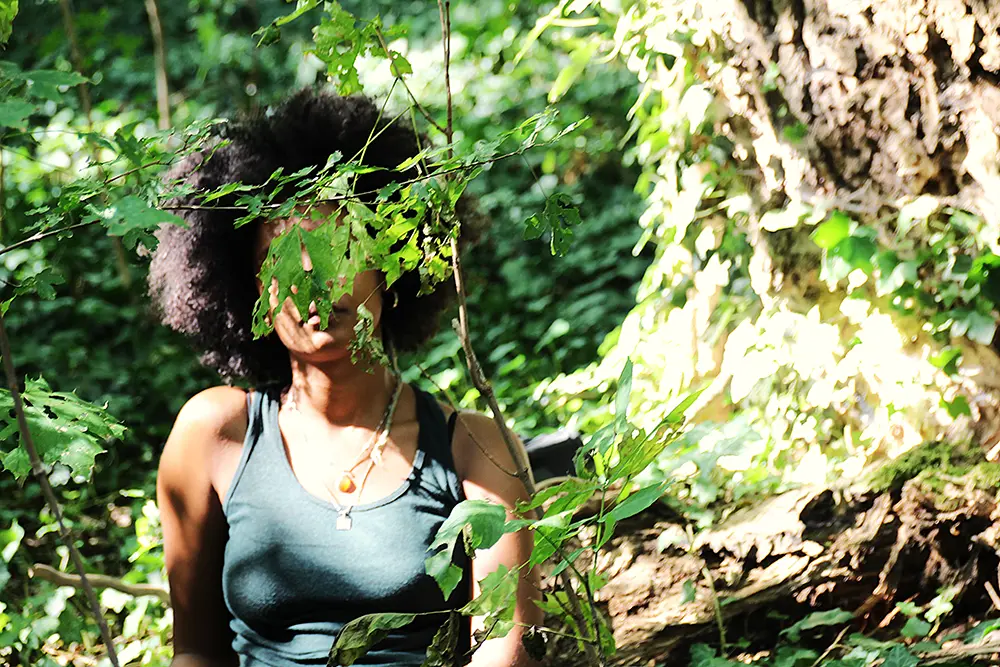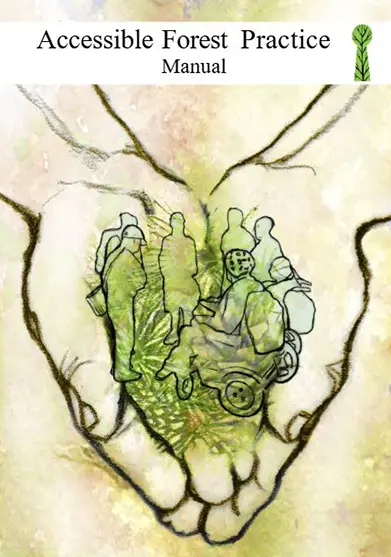Mais conteúdo
Bem-vindo ao percurso educativo da Prática Accessible Forest!

Imagina uma bússola com quatro direções, cada uma oferecendo diferentes competências:

Por onde começar?
Estes materiais educativos oferecem uma jornada com quatro percursos possíveis. Uma sugestão de caminho a tomar é apresentado abaixo, mas o ritmo e a ordem podem ser adaptados inteiramente às tuas preferências.
Passo 1
Familiariza-te com o contexto do projeto — vê os podcasts da página principal e lê a informação do projeto. Lê também o capítulo de Introdução no Manual Ebook..
Tempo estimado: 1.5 horas.
Passo 2
Oeste: Conexão com a Natureza – fortalece a tua relação com a natureza. Sem esta relação, a Prática Accessible Forest não pode ser realizada.
Encontrarás nesta página gravações áudio, videocasts e modelos educativos para aprofundares esta ligação. Uma das experiências-chave é a tua imersão na natureza – para isso, podes escolher uma das quatro gravações áudio da nossa coleção ou participar num banho de floresta organizado.
Tempo estimado: 6 horas para os materiais; várias semanas para a prática em si.
Passo 3
Este: Grupo – aprende sobre diferentes grupos vulneráveis, as suas necessidades e características, e desenvolve competências para trabalhar com eles. Só assim poderás garantir uma experiência positiva e segura na natureza.
Fonte principal: Manual Ebook Accessible Forestl.
Tempo estimado: 20 horas para os materiais; várias semanas para a prática com grupos.
Passo 4
Norte: Autoconsciência – prepara-te mentalmente para receber grupos na natureza e analisa as tuas competências. Nesta página, encontrarás gravações áudio, videocasts e modelos educativos para te apoiar na autorreflexão e no desenvolvimento de competências, atitudes e conhecimentos.
Tempo estimado: 3 horas para os materiais; vários dias para o trabalho pessoal.
Passo 5
Sul: Prática – dedica tempo a preparar corretamente uma experiência segura na natureza com o grupo escolhido. Prepara o local, os participantes, os equipamentos e a equipa.
Fonte principal: Manual Ebook Accessible Forest.
Tempo estimado: 3 horas para os materiais; várias semanas para a preparação prática.
Quanto tempo é necessário para preparar a Prática Accessible Forest?
Não te precipites em realizar a tua primeira experiência. Recomenda-se um tempo de preparação e planeamento de pelo menos dois meses para conhecer bem o Manual Ebook Accessible Forest e explorar as quatro direções da bússola de competências.
Aspetos Legais
Estes materiais contêm orientações e ferramentas para apoiar experiências inclusivas e significativas de imersão na natureza, mas não substituem aconselhamento jurídico profissional adaptado ao teu contexto.
Consulta as autoridades legais, ambientais ou administrativas competentes para garantir que as tuas atividades cumprem todos os requisitos locais.
Ao organizares passeios na natureza, assumes total responsabilidade pelas questões legais relacionadas com as tuas iniciativas.
Em que línguas estão disponíveis estes materiais?
- Inglês é a língua principal do projeto.
- Em polaco, português, alemão e húngaro, a maioria dos materiais foi traduzida, mas alguns permanecem em inglês.
- O manual educativo está disponível em todas as línguas; as diferenças dizem respeito a materiais suplementares (fichas de trabalho, podcasts e gravações áudio).
Vamos desenvolver juntos a comunidade da Prática Accessible Forest!
Manual Accessible Forest

Manual Accessible Forest
Este é o material educativo mais importante de todo o projeto. Sem se familiarizar completamente com este manual, não é possível compreender totalmente a Prática Accessible Forest.
Este material em formato PDF e EPUB constitui a base do conhecimento sobre a Prática Accessible Forest. O manual contém aproximadamente 200 páginas de texto e mais de 200 ilustrações e fotografias de caminhadas reais realizadas como parte do projeto. O manual baseia-se no modelo de competências das Práticas Accessible Forest. Apresenta o contexto mais amplo destas práticas, contém descrições de experiências específicas com grupos vulneráveis e oferece ferramentas para avaliar as suas próprias competências.
O manual contém orientações específicas adaptadas às necessidades particulares de cada um dos seguintes grupos:
- Pessoas com deficiências intelectuais e/ou físicas
- Pessoas com problemas de saúde mental
- Idosos
- Pessoas com dificuldades relacionadas ao uso excessivo de dispositivos digitais
- Migrantes, incluindo refugiados
Tempo estimado: Familiarizar-se com o conteúdo do manual levará aproximadamente 13 horas. No entanto, o tempo pode se estender significativamente, dependendo do tempo necessário para reflexão pessoal e análise de competências.

Oeste: Conexão com a natureza

Esta direção centra-se na sua relação com a natureza e na sua capacidade de criar uma ligação consciente entre os participantes e o mundo natural. Aqui, a sua relação com a natureza, a consciência ecológica e a compreensão dos ecossistemas são de extrema importância.
Questões para reflexão:
- Que atividades podem aprofundar a conexão com a natureza?
- Como podemos abordar o ambiente natural para criar uma melhor experiência para os participantes?
O desenvolvimento destas competências permitirá que você proporcione uma experiência autêntica e alinhada com a natureza para os outros.
Materiais educativos:
Leia o Manual da Floresta Acessível e, em seguida, explore os materiais restantes:
Videocast:
Audio recordings:
Templates: (files in PDF)
- Download "Relationship with Nature" (PDF, 0.3 MB)
- Download "Environmental awareness" (PDF, 0.5 MB)
- Download "Leaf Movie" (PDF, 0.5 MB)
- Download "Connect to a Tree" (PDF, 0.5 MB)
- Download "Cultivating/Encouraging Relationship with Nature" (PDF, 0.9 MB)
- Download "Adoring nature - Sit Spot Practice" (PDF, 0.4 MB)
- Download "Smell" (PDF, 0.4 MB)
- Download "Hearing" (PDF, 0.3 MB)
- Download "Universal Walk Model" (PDF, 0.7 MB)
- Download "Heart" (PDF, 0.5 MB)
- Download "Connection with nature" (PDF, 0.7 MB)

Leste: Grupo

Esta direção concentra-se nas competências relacionadas com o trabalho com os participantes em caminhadas na natureza. Aqui, é essencial compreender as necessidades dos participantes, os seus estados emocionais e a dinâmica do grupo, bem como adaptar o seu estilo de comunicação e abordagem de facilitação ao caráter do grupo. Deve também considerar como tornar o espaço e a linguagem acessíveis a todos, promovendo simultaneamente a coesão do grupo.
Questões para reflexão:
- Quais são as necessidades e expectativas dos participantes?
- Como posso adaptar a linguagem e o estilo de facilitação às características do grupo?
- Quais ferramentas e métodos de comunicação serão mais eficazes?
- Como o ambiente natural pode apoiar a dinâmica do grupo?
Essas competências permitirão que crie um ambiente acolhedor e inclusivo, enriquecendo a experiência compartilhada de caminhadas na floresta e respondendo às necessidades específicas de diferentes grupos.
Materiais educativos:
Videocasts:
Templates: (files in PDF)
- Download "Listening attentively" (PDF, 0.6 MB)
- Download "Communication" (PDF, 0.9 MB)
- Download "Communication, verbal and nonverbal" (PDF, 0.8 MB)
- Download "Knowledge about participants" (PDF, 0.6 MB)
- Download "Responsibility for each member of the group" (PDF, 0.4 MB)
- Download "Knowledge about accessibility" (PDF, 0.8 MB)
- Download "Accessibility knowledge for a specific population - Facilitation of Nature Connection" (PDF, 0.5 MB)
- Download "Basic knowledge about vulnerable groups" (PDF, 0.5 MB)
- Download "A Dozen Practical Tips for Forest Walks with Children (6–12 years)" (PDF, 0.4 MB)
- Download "Leave your phone behind" (PDF, 0.4 MB)
- Download "Map of reflection" (PDF, 0.8 MB)
- Download "Embracing acculturation stress and vulnerability" (PDF, 0.3 MB)
- Download "Embracing cultural differences" (PDF, 0.3 MB)

Norte: Autoconsciência

Esta direção da bússola enfatiza a autoconsciência. Ela concentra-se nas competências relacionadas com a sua autorreflexão. A autoconsciência é a base da liderança eficaz – significa compreender os seus próprios pontos fortes, limitações e recursos.
As competências-chave nesta área incluem a capacidade de autorreflexão, habilidades construtivas de autoavaliação, conhecimento dos seus próprios pontos fortes e fracos e flexibilidade para se adaptar a diferentes situações.
Questões para reflexão:
- Quais são os meus pontos fortes e limitações no contexto da prática da AFP?
- De que recursos preciso para criar um ambiente favorável e facilitar eficazmente uma experiência na natureza?
- Como é que a minha visão e intenções pessoais influenciam a minha forma de liderar?
Ao explorar estas questões, irá desenvolver uma compreensão mais profunda do seu próprio papel na facilitação de caminhadas na natureza e cultivar a confiança e a humildade essenciais para uma boa prática da AFP.
Materiais educativos:
Leia o Manual Accessible Forest e, em seguida, explore os restantes materiais:
Videocats:
Audiorecordings:
Templates:

Sul: Prática

Esta direção concentra-se na prática como base para preparar e orientar grupos através de processos específicos em ambientes naturais. Enfatiza as competências práticas essenciais para o planeamento de sessões, habilidades organizacionais, gestão de recursos e a capacidade de se adaptar a condições variáveis durante a prática.
Questões para reflexão:
- Considerando as minhas experiências anteriores, que passos devo tomar para preparar o local e as ferramentas para as sessões?
- Que ações específicas tomarei para apoiar as experiências dos participantes durante a prática?
- Que recursos são cruciais para que os participantes se sintam confortáveis e seguros?
Através destas questões, pode preparar uma experiência que fortaleça a sua capacidade de planear, adaptar e facilitar eficazmente as sessões, garantindo que os participantes tenham um ambiente de apoio.
Materiais educativos:
Leia o Manual Accessible Forest e, em seguida, explore os restantes materiais:
Videocats:
Audiorecordings:
Templates:
- Download "Sense of touch" (PDF, 0.4 MB)
- Download "Specifics of the location of a walk / Trail" (PDF, 0.4 MB)
- Download "Story of the Seed" (PDF, 0.3 MB)
- Download "My Forest Walk - Playfulness" (PDF, 2 MB)
- Download "Make a Photo" (PDF, 0.6 MB)
- Download "Group dynamics" (PDF, 0.3 MB)
- Download "First Aid" (PDF, 0.3 MB)
- Download "Nonjudgmental communication" (PDF, 0.3 MB)
- Download "Inclusive communication - beyond words" (PDF, 1.1 MB)


